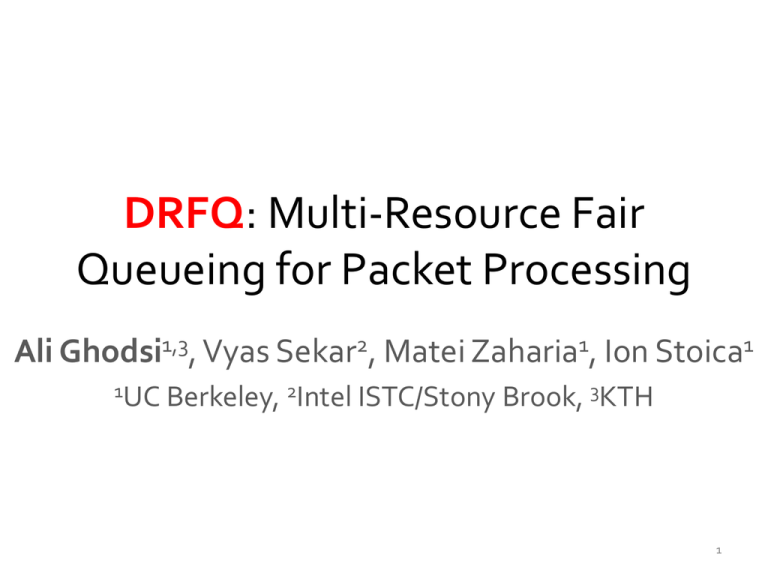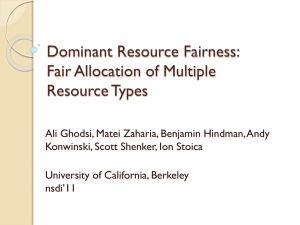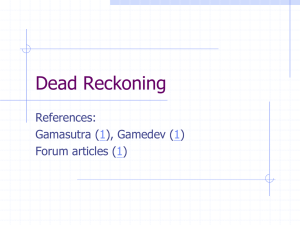pptx - Stanford University Networking Seminar
advertisement

DRFQ: Multi-Resource Fair
Queueing for Packet Processing
Ali Ghodsi1,3, Vyas Sekar2, Matei Zaharia1, Ion Stoica1
1UC Berkeley, 2Intel ISTC/Stony
Brook, 3KTH
1
Increasing Network Complexity
• Packet processing becoming evermore sophisticated
–
–
–
–
Software Defined Networking (SDN)
Middleboxes
Software Routers (e.g. RouteBricks)
Hardware Acceleration (e.g. SSLShader)
• Data plane no longer merely forwarding
–
–
–
–
WAN optimization
Caching
IDS
VPN
2
Motivation
• Flows increasingly have
heterogeneous resource consumption
– Intrusion detection bottlenecking on CPU
– Small packets bottleneck memory-bandwidth
– Unprocessed large packets bottleneck on link bw
Scheduling based on a single resource insufficient
3
Problem
How to schedule packets from different flows,
when packets consume multiple resources?
How to generalize fair queueing to multiple
resources?
4
Contribution
Allocation
in Space
Allocation
in Time
Single-Resource
Fairness
Max-Min
Fairness
Fair
Queueing
Multi-Resource
Fairness
DRF
DRFQ
Generalize Virtual Time to Multiple Resources
5
Outline
•
•
•
•
Analysis of Natural Policies
DRF allocations in Space
DRFQ: DRF allocations in Time
Implementation/Evaluation
6
Desirable Multi-Resource Properties
• Share guarantee:
– Each flow can get 1/n of at least one resource
• Strategy-proofness:
– A flow shouldn’t be able to finish faster by
increasing the resources required to process it.
7
Violation of Share Guarantee
• Example of FQ applied to a
– Two resources CPU and NIC, used serially
– Two flows with profiles <2 μs,1 μs> and <1 μs,1 μs>
– FQ based on NIC alternates one packet from each flow
CPU
p1
p1
NIC
time 0
p2
p1
1
2
p2
p1
3
p3
p2
4
5
p2
6
p4
p3
7
100%
33%
p3
33%
8
flow 1
flow 2
p3
9
10
11
flow 1
flow 2
50%
66%
33%
0%
CPU
NIC
Share Guarantee Violated by Single Resource FQ
8
Violation of Strategy-Proofness
• Bottleneck fairness
– Determine which resource is bottlenecked
– Apply FQ to that resource
• Example with Bottleneck Fairness
– 2 resources (CPU, NIC), 3 flows <10,1>, <10,14>, <10,14>
– CPU bottlenecked and split equally
100%
flow 1
100%
flow 2
50%
50%
33%
0%
CPU
NIC
0%
48%
33%
CPU
NIC
flow 3
– Flow 1 changes to <10,7>. NIC bottlenecked and split equally
Bottleneck Fairness Violates Strategy-Proofness
9
Natural Policy
• Per-Resource Fairness (PRF)
– Have a buffer between each resource
– Apply fair queueing to each resource
• Per-Resource Fairness not strategy-proof
– 2 resources, 2 flows <4,1>, <1,2>
100%
43%
86%
50%
100%
66%
66%
33%
CPU
NIC
Flow 1
Flow 2
50%
57%
0%
33%
14%
CPU
NIC
0%
– Flow 1 changes demand to <4,2>
11
Problems with Per-Resource Fairness
• PRF violates strategy-proofness
– Can be manipulated by wasting resources
• PRF requires per-resource queues
– Problematic for parallel resource consumption
e.g. CPU and memory consumption in a module
12
Why care about strategy-proofness?
• Lack of strategy-proofness encourages wastage
– Decreasing goodput of the system
• Networking applications especially savvy
– Peer-to-peer apps manipulate to get more resources
• Trivially guaranteed for single resource fairness
– But not for multi-resource fairness
13
Summary of Policies
Policy
Share
Guarantee
StrategyProofness
Fair Queueing a Single
Resource
Bottleneck Fairness
Per-Resource Fairness
X
Dominant Resource Fairness
X
X
14
Outline
•
•
•
•
Analysis of Natural Policies
DRF allocations in Space
DRFQ: DRF allocations in Time
Implementation/Evaluation
15
Dominant Resource Fairness
• DRF originally in the cloud computing context
– Satisfies share guarantee
– Satisfies strategy-proofness
16
DRF Allocations
• Dominant resource of a user is the resource she is allocated
most of
– Dominant share is the user’s share of her dominant resource
• DRF: apply max-min fairness to dominant shares
– ”Equalize” the dominant share of all users
Total resources:
User 1 demand:
User 2 demand:
<16 CPUs, 16 GB mem>
<3 CPU, 1 GB mem> dom res: CPU
<1 CPU, 4 GB mem> dom res: mem
100%
3 CPUs
12 GB
User 1
User 2
66%
50%
66%
0%
12 CPUs
CPU
4 GB
mem
17
Allocations in Space vs Time
• DRF provides allocations in space
– Given 1000 CPUs and 1 TB mem, how much to
allocate to each user
• DRFQ provides DRF allocations in time
– Multiplex packets to achieve DRF allocations over
time
18
Outline
•
•
•
•
Analysis of Natural Policies
DRF allocations in Space
DRFQ: DRF allocations in Time
Implementation/Evaluation
19
Determining Packet Resource
Consumption
• A-priori packet link usage known in FQ
– Packet size divided by throughput of link
• Packet processing time a-priori unknown for
multi-resources
– Depends on the modules that process it
• Leverage Start-time Fair Queueing (SFQ)
– Schedules based on virtual start time of packets
– Start time of packet p independent of resource
consumption of packet p
20
Memoryless Requirement
• Virtual Clock simulates flows with dedicated 1/n link
– Attach start and finish tags according to dedicated link
– Serve packet with smallest finish tag (work conserving)
• Problem
– During light load a flow might get more than 1/n
– That flow experiences long delays when new flows start
• Requirement: memoryless scheduling
– A flow’s share of resources should be independent of its
share in the past
21
Memoryless through Virtual Time
– A unit of virtual time
always corresponds to same
amount of service
• Example with 2 flows
– Time 0: one backlogged flow
– Time 20: two backlogged flows
Virtual Time V(t)
• Virtual time to track amount service received
60
40
20
20
• Schedule the packets according to V(t)
40
60
80
Real Time
– Assign virtual start/finish time when packet arrives
Dove-tailing Requirement
• FQ: flow size should determine service, not packet size
– Flow with 10 1kb packets gets same service as 5 2kb packets
• Want flow processing time, not packet processing time
– Example: give same service to these flows:
Flow 1: p1 <1,2>, p2 <2,1>, p3 <1,2>, p4 <2,1>, …
Flow 2: p1 <3,3>, p2 <3,3>, p3<3,3>, p4 <3,3>, …
• Requirement: dove-tailing
– Packet processing times should be independent of how
resource consumption is distributed in a flow
23
Tradeoff
• Dovetailing and memoryless property at odds
– Dovetailing needs to remember past consumption
• DRFQ developed in three steps
– Memoryless DRFQ: uses a single virtual time
– Dovetailing DRFQ : use virtual time per resource
– DRFQ: generalizes both, tradeoff between
memoryless and dovetailing
24
Memoryless DRFQ
• Attach a virtual start and finish time to every packet
– S(p) and F(p) of packet p
• Computing virtual finish time F(P)
1. F(p) = S(p) + maxi{ p_time(p, i) }
p_time(p, i) = { processing time of p on resource i }
• Computing virtual start time, S(p)
2. S(p) = max( F(p-1), C(t) )
C(t) = { max start time of currently serviced packet }
• Service the packet with minimum virtual start time
25
Memoryless DRFQ example
• Two flows become backlogged at time 0
– Flow 1 alternates <1,2> and <2,1> packet processing
– Flow 2 uses <3,3> packet processing time
1. F(p) = S(p) + maxi{ p_time(p, i) }
2. S(p) = max( F(p-1), C(t) )
Flow 1 P5
S: 8 F: 10
Flow 1 P4
S: 6 F: 8
Flow 1 P3
S: 4 F: 6
Flow 1 P2
S: 2 F: 4
Flow 1 P1
S: 0 F: 2
Flow 2 P3
S: 6 F: 9
Flow 2 P2
S: 3 F: 6
Flow 2 P1
S: 0 F: 3
Flow 1 gets worse service than Flow 2
27
Dovetailing DRFQ
• Keep track of start and finish time per resource
– Use max start time per resource for scheduling
– Dovetail by keeping track of all resource usage
28
Dovetailing DRFQ example
• Two flows become backlogged at time 0
– Flow 1 alternates <1,2> and <2,1> packet processing
– Flow 2 uses <3,3> per packet
Flow 1
S1: 6 F1: 7
S2: 6 F2: 8
Flow 1
S1: 4 F1: 6
S2: 5 F2: 6
Flow 1
S1: 3 F1: 4
S2: 3 F2: 5
Flow 1
S1: 1 F1: 3
S2: 2 F2: 3
Flow 1
S1: 0 F1: 1
S2: 0 F2: 2
Flow 2
S1: 6 F1: 9
S2: 6 F2: 9
Flow 2
S1: 3 F1: 6
S2: 3 F2: 6
Flow 2
S1: 0 F1: 3
S2: 0 F2: 3
Dovetailing ensures both flows get same service
29
DRFQ algorithm
• DRFQ bounds dovetailing to Δ processing time
– Dovetail up to Δ processing time units
– Memoryless beyond Δ
• DRFQ is a generalization
– When Δ=0 then DRFQ=memoryless DRFQ
– When Δ=∞ then DRFQ=dovetailing DRFQ
• Set Δ to a few packets worth of processing
30
Outline
•
•
•
•
Analysis of Natural Policies
DRF allocations in Space
DRFQ: DRF allocations in Time
Implementation/Evaluation
31
Isolation Experiment
• DRFQ Implementation in Click
– 2 elephants: 40K/sec basic, 40K/sec IPSec
– 2 mice:
1/sec basic, 0.5/sec basic
Non-backlogged flows isolated from backlogged flows32
Simulating Bottleneck Fairness
• 2 flows and 2 res. <CPU, NIC>
– Demands <1,6> and <7,1> bottleneck unclear
• Especially bad for TCP and video/audio traffic
33
Summary
• Packet processing becoming evermore sophisticated
– Consume multiple resources
• Natural policies not suitable
– Per-Resource Fairness (PRF) not strategy-proof
– Bottleneck Fairness doesn’t provide isolation
• Proposed Dominant Resource Fair Queueing (DRFQ)
–
–
–
–
Generalization of FQ to multiple resources
Generalizes virtual time to multiple resources
Provides tradeoff between memoryless and dovetailing
Provides share-guarantee (isolation) and strategyproofness
34
35
36
Overhead
• 350 MB trace run through our Click
implementation
• Evaluate overhead of two modules
– Intrusion Detection, 2% overhead
– Flow monitoring, 4% overhead
37
Determining Resource Consumption
• Resource consumption obvious in routers
– Packet size divided by link rate
• Generalize consumption to processing time
– Normalized time a resource takes to process packet
• Normalized processing time
– e.g. 1 core takes 20μs to service a packet,
on a quad-core the packet processing time is 5μs
– Packet processing time ≠ packet service time
38
Module Consumption Estimation
• Linear estimation of processing time
– For module m and resource r as function of packet size
• R2 > 0.90 for most modules
39
Simulating Bottleneck Fairness
• 2 flows and 2 res. <CPU, NIC>
– Demands <1,6> and <7,1> bottleneck unclear
– CPU bottleneck: 7×<1,6> + <7,1> = <14,43>
– NIC bottleneck: <1,6> + 6×<7,1> = <43, 12>
– Periodically oscillates the bottleneck
40
TCP and oscillations
• Implemented Bottleneck Fairness in Click
– 20 ms artificial link delay added to simulate WAN
– Bottleneck determined every 300 ms
– 1 BW-bound flow and 1 CPU-bound flow
Oscillations in Bottleneck degrade performance of TCP
41
Multi-Resource Consumption Contexts
• Different modules within a middlebox
– E.g. Bro modules for HTTP, FTP, telnet
• Different apps on a consolidated middlebox
– Different applications consume different resources
• Other contexts
– VM scheduling in hypervisors
– Requests to a shared service (e.g. HDFS)
42









